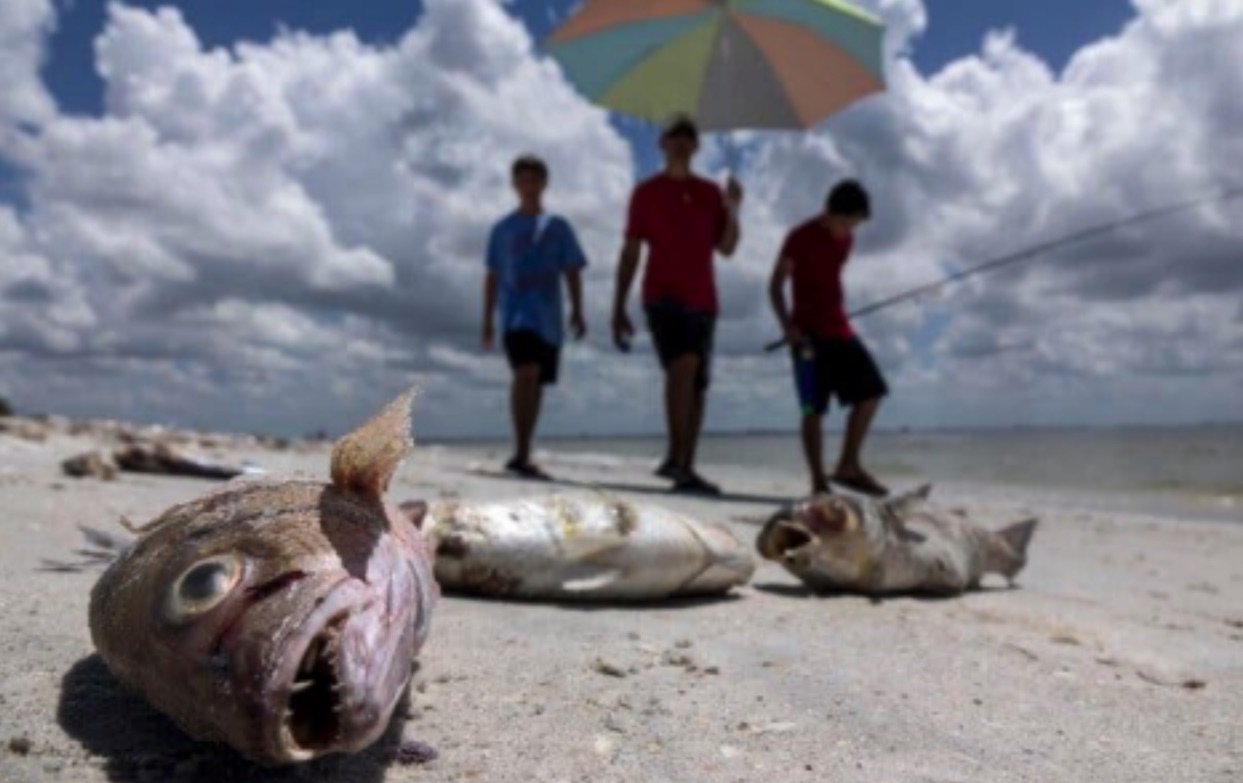Red Tide, Take Warning
Perhaps the disaster that struck Florida’s southwest coast this summer will cause residents to rethink the way they live.
Fish killed by red tide in August in Captiva, Fla. (Photo Credit: Cristobal Herrera/EPA, via Shutterstock)
(Mr. White, a former Florida fishing guide, is a bestselling novelist and owner of the Doc Ford’s Rum Bars and Grilles restaurant franchise)
SANIBEL ISLAND, Fla. — As the Spanish cartographer Juan López de Velasco sailed along southwest Florida in 1575, he was greeted by a sight that became odiously familiar this summer to those on the peninsula he mapped for the Spanish Empire so long ago. “The coast is all in ruin,” he wrote in his journal, “because in these four or five leagues of sea there is barely 1.5 fathoms of water where many fish are dying.”
It is possible that López made this entry within sight of the shell mound where my house of yellow pine has, since 1926, witnessed a time warp flow of conquistadors, past and present, and too many harmful algae blooms to count.
Rather than puzzle over the mystery of dying fish, López continued south to Cuba. A wise choice. The people who built the mound (contemporaries of the Aztec) disliked interlopers, as proved in 1521 when, on the same bay, near Sanibel Island, they sent Ponce de León packing with a lethal arrow to the thigh. The Calusa, as the indigenous are called, were no less hostile to conquistadors than was the land they inhabited — a lesson modern interlopers would do well to remember.
A typical lethal algae bloom, also known as red tide, moves like a slow-motion hurricane, piling itself ashore with an epicenter that, geographically, varies along the coast. Fishing might be great in Tampa Bay but a waste of time near Sanibel, as was true until recently. As history all but guarantees, it will happen again. As of now, though, the view from my dock includes islands where the beaches are clean and clear — and empty of tourists who still fear the stink and airborne toxins that irritate eyes and lungs. And possibly worse, if certain noxious blue-green bacteria flood into the mix, as was the case this summer. But more on that later.
During my 50 years on this coast, I’ve experienced four killer algae blooms as a fishing guide (1972, ’82, ’96 and 2004). As a novelist, I’ve researched the subject, yet my understanding lacks the certainty of newcomers unacquainted with these blooms. Every 10 to 15 years, often after a rainy winter or hurricane, acres of bloated fish wash ashore, as well as bottlenose dolphins and manatees. These are lovable mammals with Disney faces — unless poisoned by lethal toxins. On the heels of public outrage come theories. Biologists squabble, environmental groups debate. Learjet conquistadors swoop in, aspirant politicians who see Florida as an untethered plum and who buy their way into office with big bucks and bumper-sticker cures.
If one faction disagrees, there are charges of collusion or worse. Finger-pointing ensues, and the usual suspects have not changed: 1.) the state’s sprawling sugar cane industry, south of Lake Okeechobee, which accounts for almost half of the nation’s sugar cane production. 2.) Phosphate mining north of the lake that supplies three-fourths of the phosphate used in the country. It makes sense. Fertilizer causes organisms to grow, right? A few disasters ago, I would have joined in lock step behind this theory, but recent events and a quick, unsavory review of history have caused me to reassess.
As reported by the University of Miami in 1955, what was thought to be Florida’s first documented red tide was in 1844 off Sarasota — “A widespread destruction of all sorts of saltwater animal life,” according to an anecdotal account. Between 1854 and 1880 there were three more serious blooms, the worst in 1878. “Portions of our Gulf waters became poisoned in some way that caused the death of all fish that they came into contact with,” wrote another chronicler. The cause most commonly cited was, in the words of others, freshwater that flows out of the Everglades “in great volumes.”
In those years, the Everglades’ ‘River of Grass’ was the consensus enemy and treated as such.
But projects that stemmed the flow of water through the Glades to the gulf — like building the Tamiami Trail from Naples to Miami in the 1920s — didn’t stop the red tides, either. Later, phosphate mining and the sugar cane industry became, in the minds of many, synonymous with algae blooms. But people either forgot or were unaware that these blooms were happening long before those industries arrived. All of which underscores the complexities of the phenomenon.
In 1947, as reported by The St. Petersburg Times, there was a red tide so horrific that Navy warships were summoned to “disperse a putrid fish kill along 35 miles” of coast. Government funds were allocated (until the hysteria passed — a pattern that continues to this day), and scientists rallied to the cause. Throughout the 1950s researchers sought to identify factors that exacerbated what, by 1971, was acknowledged to be a global natural phenomenon. Theories ranged from hydrogen bombs to septic tank offal to excess nutrients such as iron, phosphates and nitrates.
Notice a pattern? Fifty years later, mega hectares of wilderness have been displaced by stucco communities as prissy about lawn maintenance as the golf courses and Disney attractions they border.
More fertilizer is consumed in Florida than any other state but California, Illinois and Texas. Thirty percent of the state's population uses septic systems. And about 900 people move each day to Florida — a blossoming whose parallel to red tides is obvious. And the irony stings.
All this on a peninsula that has been accurately described as a waterscape elevated only by porous limestone and fragile karst geology. How porous? You can’t spit near Disney World without your DNA ending up in Lake Okeechobee or, more likely, the Gulf of Mexico, if the Army Corps of Engineers is involved. For decades, the corps has invited disaster by conveying most of Lake Okeechobee’s discharge west to the gulf, the birthplace of nearly all killer red tides.
Which brings us back to this summer’s disaster. It was, according to Brian Lapointe, a research professor at the Harbor Branch Oceanographic Institute, a rare collision between disparate blooms that were, inaccurately, portrayed as one bloom: a marine-borne red tide, and a freshwater infestation of blue-green algae. The saltwater phenomenon begins far out in the gulf. If conditions move the bloom ashore, the degree to which it is sustained or accelerated by nutrients, natural or man-made, is the subject of rancorous debate. In Florida, however, the cause of the blue-green algae has been directly linked to septic tanks, according to the Harbor Branch Institute.
The severity of this event should change the way we think. Why? Because we are the usual suspects. This disaster, in fact, could be a blessing, for it has rallied Floridians via images of dead turtles and dolphins that might remain fresh in the mind beyond the November election. Floridians – despite what you read – are not all goofballs and newcomer ‘experts’ who default to the same old bumper sticker cures. And whole communities are starting to address backyard threats: septic tanks and fertilizer-curried lawns that seem benign until a blue-green effluvium bubbles up and sends residents packing — not unlike a long-gone interloper in 1521.
Randy Wayne White is a novelist and a former fishing guide.
Follow The New York Times Opinion section on Facebook and Twitter (@NYTopinion).

